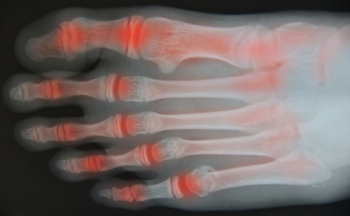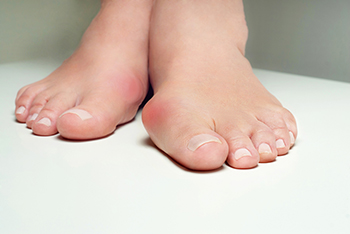Connect With Us
Blog
Items filtered by date: April 2023
Flat Feet Development in Children

Flat feet is an affliction in which the arches of the feet disappear or were never properly developed. As a result, the entire soles of the feet rest flush against the floor. Many new parents often wonder whether it is natural for their babies to have flat feet. They also often ask podiatrists when it is normal for their babies to develop arches in the feet. Although these answers are not ironclad and completely consistent from person to person, several rules of thumb might be gleaned. Typically speaking, newborn babies are born without foot arches. However, they commonly begin to develop by the time the child is about 3 years old. It is also important to note that young children might have either of two types of flat feet: rigid or flexible. If you are a new parent and want to make sure that your child’s feet are developing properly, it is suggested that you schedule an appointment with a podiatrist today.
Flatfoot is a condition many people suffer from. If you have flat feet, contact Eugene Little, DPM from Foot and Ankle Centers of Ohio. Our doctor will treat your foot and ankle needs.
What Are Flat Feet?
Flatfoot is a condition in which the arch of the foot is depressed and the sole of the foot is almost completely in contact with the ground. About 20-30% of the population generally has flat feet because their arches never formed during growth.
Conditions & Problems:
Having flat feet makes it difficult to run or walk because of the stress placed on the ankles.
Alignment – The general alignment of your legs can be disrupted, because the ankles move inward which can cause major discomfort.
Knees – If you have complications with your knees, flat feet can be a contributor to arthritis in that area.
Symptoms
- Pain around the heel or arch area
- Trouble standing on the tip toe
- Swelling around the inside of the ankle
- Flat look to one or both feet
- Having your shoes feel uneven when worn
Treatment
If you are experiencing pain and stress on the foot you may weaken the posterior tibial tendon, which runs around the inside of the ankle.
If you have any questions please feel free to contact our office located in Sidney, OH . We offer the newest diagnostic and treatment technologies for all your foot and ankle needs.
Plantar Fasciitis Can Be Caused by Playing Pickleball

Pickleball has become a popular sport in recent years. It is a mix between tennis, badminton, and ping pong. While it is exciting to experience the thrill of victory, it may come with having foot pain. The game is played by pushing off on the ball of the foot, and this may cause the plantar fascia to undergo stress. When played frequently, it may lead to plantar fasciitis, which is the inflammation and irritation of the plantar fascia. This is the band of tissue that connects the heels to the toes, and provides the ability to walk and run. Effective stretches for the plantar fascia can begin with rolling the affected foot on a tennis ball or frozen water bottle. This can help to strengthen the arch of the foot. Some people find it helpful to wear custom-made orthotics, in addition to choosing shoes that fit correctly. If you are interested in playing pickleball, it is suggested that you confer with a podiatrist who can guide you toward techniques that can protect the plantar fascia.
Foot Pain
Foot pain can be extremely painful and debilitating. If you have a foot pain, consult with Eugene Little, DPM from Foot and Ankle Centers of Ohio. Our doctor will assess your condition and provide you with quality foot and ankle treatment.
Causes
Foot pain is a very broad condition that could be caused by one or more ailments. The most common include:
- Bunions
- Hammertoes
- Plantar Fasciitis
- Bone Spurs
- Corns
- Tarsal Tunnel Syndrome
- Ingrown Toenails
- Arthritis (such as Gout, Rheumatoid, and Osteoarthritis)
- Flat Feet
- Injury (from stress fractures, broken toe, foot, ankle, Achilles tendon ruptures, and sprains)
- And more
Diagnosis
To figure out the cause of foot pain, podiatrists utilize several different methods. This can range from simple visual inspections and sensation tests to X-rays and MRI scans. Prior medical history, family medical history, and any recent physical traumatic events will all be taken into consideration for a proper diagnosis.
Treatment
Treatment depends upon the cause of the foot pain. Whether it is resting, staying off the foot, or having surgery; podiatrists have a number of treatment options available for foot pain.
If you have any questions, please feel free to contact our office located in Sidney, OH . We offer the newest diagnostic and treatment technologies for all your foot care needs.
Why Live with Pain and Numbness in Your Feet?
Arthritis Can Affect the Toes

When arthritis develops in the foot, the toes are the most often affected. Arthritis is defined as chronic inflammation that is often accompanied by tenderness, swelling, stiffness, and pain. Toe arthritis is caused by gradual wear and tear of the cartilage. This is what cushions the bones that surround the joints, and is found in two forms of arthritis. Osteoarthritis (OA) is a common form of this condition, in addition to rheumatoid arthritis (RA), which is an autoimmune disease. The bottom of the big toe can become sore with arthritis, and may become worse while walking and standing. The range of motion may be limited, and this may be a result of the loss of cartilage between the bones. Treatment for arthritis can begin after a diagnosis has confirmed it. There are various types of relief that can be found, and it may start by wearing high-quality shoes. If you are afflicted with arthritis in the feet, it is suggested that you consult with a podiatrist who can offer you treatment solutions that are best for you.
Arthritis can be a difficult condition to live with. If you are seeking treatment, contact Eugene Little, DPM from Foot and Ankle Centers of Ohio. Our doctor can provide the care you need to keep you pain-free and on your feet.
Arthritic Foot Care
Arthritis is a joint disorder that involves the inflammation of different joints in your body, such as those in your feet. Arthritis is often caused by a degenerative joint disease and causes mild to severe pain in all affected areas. In addition to this, swelling and stiffness in the affected joints can also be a common symptom of arthritis.
In many cases, wearing ill-fitting shoes can worsen the effects and pain of arthritis. Wearing shoes that have a lower heel and extra room can help your feet feel more comfortable. In cases of rheumatoid arthritis, the arch in your foot may become problematic. Buying shoes with proper arch support that contour to your feet can help immensely.
Alleviating Arthritic Pain
- Exercises that stretch the foot can prevent further pain and injury and increase mobility
- Most of the pain can be alleviated with anti-inflammatory drugs, heat, and topical medications
- Massages can help temporarily alleviate pain.
It is best to see your doctor for the treatment that is right for your needs and symptoms. Conditions vary, and a podiatrist can help you determine the right method of care for your feet.
If you have any questions, please feel free to contact our office located in Sidney, OH . We offer the newest diagnostic tools and technology to treat your foot and ankle needs.
Wearing Tight Shoes May Cause a Bunion

A bunion can be caused for various reasons, including genetic factors, aging, and choosing shoes that do not have enough room for the toes to move freely in. Wearing tight shoes may cause a bony protrusion on the side of the big toe, which may push the other toes toward each other. The medical term for a bunion is referred to as hallux valgus, which is considered a deformity. Protruding bunions may cause pain and pressure, and medical attention is often sought for relief. Calluses and corns may form on top of the toes due to the foot touching the top or side of the shoe. Prevention methods for bunions can be implemented by wearing shoes with adequate room in the toe area, and walking barefoot can help to strengthen the overall foot. If you have developed a bunion, it is suggested that you schedule an appointment with a podiatrist who can offer you additional relief options.
If you are suffering from bunions, contact Eugene Little, DPM of Foot and Ankle Centers of Ohio. Our doctor can provide the care you need to keep you pain-free and on your feet.
What Is a Bunion?
A bunion is formed of swollen tissue or an enlargement of boney growth, usually located at the base joint of the toe that connects to the foot. The swelling occurs due to the bones in the big toe shifting inward, which impacts the other toes of the foot. This causes the area around the base of the big toe to become inflamed and painful.
Why Do Bunions Form?
Genetics – Susceptibility to bunions are often hereditary
Stress on the feet – Poorly fitted and uncomfortable footwear that places stress on feet, such as heels, can worsen existing bunions
How Are Bunions Diagnosed?
Doctors often perform two tests – blood tests and x-rays – when trying to diagnose bunions, especially in the early stages of development. Blood tests help determine if the foot pain is being caused by something else, such as arthritis, while x-rays provide a clear picture of your bone structure to your doctor.
How Are Bunions Treated?
- Refrain from wearing heels or similar shoes that cause discomfort
- Select wider shoes that can provide more comfort and reduce pain
- Anti-inflammatory and pain management drugs
- Orthotics or foot inserts
- Surgery
If you have any questions, please feel free to contact our office located in Sidney, OH . We offer the newest diagnostic and treatment technologies for all your foot care needs.

